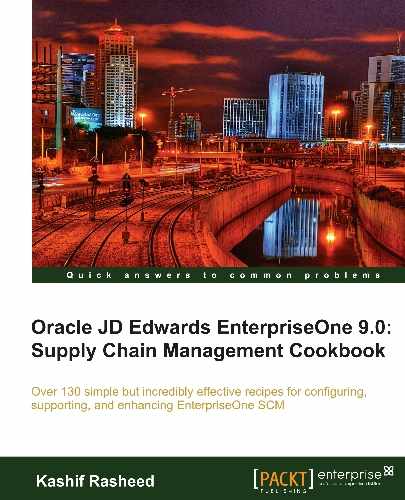What this book covers
Chapter 1, Inventory Management, discusses inventory management, which is the core module of the Supply Chain Management modules. It is necessary to understand how to set up and manage inventory in order to effectively work with all of the other programs in JD Edwards EnterpriseOne. The JD Edwards EnterpriseOne Inventory Management system defines inventory items, which enables you to manipulate inventory throughout the supply chain.
Chapter 2, Inventory Transactions, Item Quantity, and Physical Inventories, shows how to perform inventory transactions, review inventory quantity information, and perform physical inventory through cycle counts and tag counts.
Chapter 3, Updating Costs, Using Kits, and Lot Processing, gets you acquainted with updating item costs, setting up kits items, and using lot processing.
Chapter 4, Understanding and Setting up Procurement, teaches procurement management system setup, including procurement management system integration, setting up different order types, setting up order approval, and receipt routing.
Chapter 5, Understanding Pricing in Procurement and Purchase Orders, discusses procurement management system setup including procurement management system integration, setting up different order types, setup order approval and receipt route.
Chapter 6, Receipt Processing, shows purchase order receipt processing, reviewing receipt journals, standard receipt processing, and receipt routing processing.
Chapter 7, Creating Vouchers and Landed Costs, teaches how vouchers can be created based on invoice and receipt, and based on invoice and purchase order. There are two types of voucher matching, two way voucher matching and three way voucher matching. This chapter covers the voucher matching process. It also covers landed costs (the additional cost incurred during purchasing) during receipt process, and standalone landed costs.
Chapter 8, Processing Special Orders and Approvals, provides a variety of special orders that may be required depending upon the company's business process. For example, some companies require a quotation process and some companies have long-term purchase contract called blanket order with their vendors. In this chapter, you will see the processing of special orders, including requisition orders, quote orders, long term contracts, or blanket orders. This chapter will also cover generating purchase orders, and purchase order approvals including approval route set up.
Chapter 9, Sales Order Management and Additional Orders, explains the Sales Order Management system helps you to review and examine sales order information and review the sales order status, including customer payments and sales invoice standings. It also allows you to plan for future requirements. You can rapidly retrieve information such as item number, availability, quantity, cost, and so on. This chapter provides you with the details of the sales order system.
Chapter 10, Holding, Releasing, and Reviewing, provides you with the details of additional Sales Order Management system processes, which includes the release of held orders that can be set up as per the business needs. It also provides Release Quote Order and Release Blanket Order processes.
Chapter 11, Order Processing, Prepayments, and Invoicing, provides you with the details of Order Processing, which includes printing pick slip documents, running the confirm shipment process, and so on. It also provides details of invoice processing, which covers the pre-payments for advance payment processing.
Chapter 12, Updating Prices, End of Day Processes, and Sales Returns, talks about the Order Management pricing, which includes base price revisions based on customer, items, customer group, and/or item group. It also gives you the details of how to perform End of Day operations, which update the financial modules as per the financial integration setup.
Chapter 13, SCM Customizations, talks about the SCM customized objects, which provides you with the details of supply chain's commonly-used customized objects. The chapter provides both the technical specification and technical coding that the Technical Consultant and Application Programmer require.
Appendix, The Supply Chain Business Process, provides you a live case study of a supply chain implementation of a client. The business analysis document gives you the details of the As-Is and To-Be business process, which is based on JD Edwards EnterpriseOne Supply Chain Management application features.
